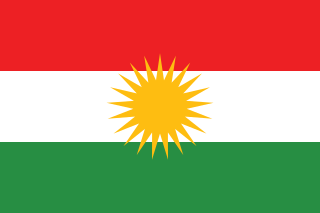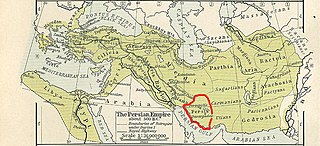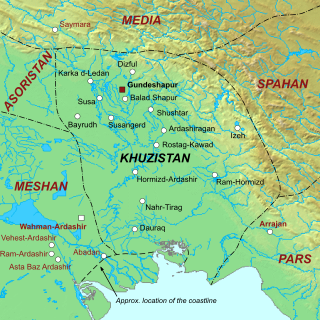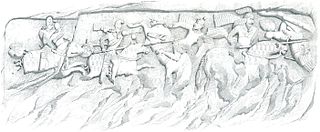Related Research Articles

Kurds or Kurdish people are an Iranic ethnic group native to the mountainous region of Kurdistan in Western Asia, which spans southeastern Turkey, northwestern Iran, northern Iraq, and northern Syria. There are exclaves of Kurds in Central Anatolia, Khorasan, and the Caucasus, as well as significant Kurdish diaspora communities in the cities of western Turkey and Western Europe. The Kurdish population is estimated to be between 30 and 45 million.

Shapur I was the second Sasanian King of Kings of Iran. The precise dating of his reign is disputed, but it is generally agreed that he ruled from 240 to 270, with his father Ardashir I as co-regent until the death of the latter in 242. During his co-regency, he helped his father with the conquest and destruction of the city of Hatra, whose fall was facilitated, according to Islamic tradition, by the actions of his future wife al-Nadirah. Shapur also consolidated and expanded the empire of Ardashir I, waged war against the Roman Empire, and seized its cities of Nisibis and Carrhae while he was advancing as far as Roman Syria. Although he was defeated at the Battle of Resaena in 243 by Roman emperor Gordian III, he was the following year able to win the Battle of Misiche and force the new Roman emperor Philip the Arab to sign a favorable peace treaty that was regarded by the Romans as "a most shameful treaty".

Atropatene, also known as Media Atropatene, was an ancient Iranian kingdom established in c. 323 BC by the Persian satrap Atropates. The kingdom, centered in present-day northern Iran, was ruled by Atropates' descendants until the early 1st-century AD, when the Parthian Arsacid dynasty supplanted them. It was conquered by the Sasanians in 226, and turned into a province governed by a marzban ("margrave"). Atropatene was the only Iranian region to remain under Zoroastrian authority from the Achaemenids to the Arab conquest without interruption, aside from being briefly ruled by the Macedonian king Alexander the Great.

Fars Province, also known as ParsProvince as well as Persis, is one of the 31 provinces of Iran. The province has an area of 122,400 km2 and is located in Iran's southwest, in Region 2. Its administrative center and capital city is Shiraz. Fars neighbours Bushehr province to the west, Hormozgan province to the south, Kerman and Yazd provinces to the east, Isfahan province to the north, and Kohgiluyeh and Boyer-Ahmad province to the northwest.

Ardashir I, also known as Ardashir the Unifier, was the founder of the Persian Sasanian Empire. He was also Ardashir V of the Kings of Persis, until he founded the new empire. After defeating the last Parthian shahanshah Artabanus IV on the Hormozdgan plain in 224, he overthrew the Parthian dynasty and established the Sasanian dynasty. Afterwards, Ardashir called himself "shahanshah" and began conquering the land that he called Iran.

Persis, also called Persia proper, is the Fars region, located to the southwest of modern-day Iran, now a province. The Persians are thought to have initially migrated either from Central Asia or, more probably, from the north through the Caucasus. They would then have migrated to the current region of Persis in the early 1st millennium BC. The country name Persia was derived directly from the Old Persian Parsa.

Artabanus IV, also known as Ardavan IV (Parthian:𐭓𐭕𐭐𐭍), incorrectly known in older scholarship as Artabanus V, was the last ruler of the Parthian Empire from c. 213 to 224. He was the younger son of Vologases V, who died in 208.
The Kār-Nāmag ī Ardašīr ī Pāpakān, is a short Middle Persian prose tale written in the Sassanid period (226-651). The story narrates the story of Ardashir I, the founder of the Sassanid dynasty. His own life story—his rise to the throne, battle against the Parthian king Ardawān, and conquest of the empire by the scion of the House of Sāsān, as well as episodes concerning his heir Šābuhr and the latter’s son, Ohrmazd.
In the Western world, Persia was historically the common name used for Iran. On the Nowruz of 1935, Reza Shah officially asked foreign delegates to use the Persian term Iran, the endonym of the country, in formal correspondence. Subsequently, the common adjective for citizens of Iran changed from Persian to Iranian. In 1959, the government of Mohammad Reza Pahlavi, Reza Shah's son, announced that both "Persia" and "Iran" could be used interchangeably, in formal correspondence. However, the issue is still debated among Iranians.

The Muslim conquest of Khuzestan took place from 637/8 to 642, and ended with the acquisition of the rich Khuzestan Province by the Rashidun Caliphate.

The SasanianEmpire or Sassanid Empire, officially known as Eranshahr also known as Second Persian Empire, or Neo-Persian Empire was the last Iranian empire before the early Muslim conquests of the 7th–8th centuries AD. Named after the House of Sasan, it endured for over four centuries, from 224 to 651 AD, making it the second longest-lived Persian imperial dynasty, after the Arsacids. The Sasanian Empire succeeded the Parthian Empire, and re-established the Persians as a major power in late antiquity alongside its neighbouring arch-rival, the Roman Empire. The empire ended with the Arab conquest of Iran.

Pabag, was an Iranian prince who ruled Istakhr, the capital of Pars, from 205 or 206 until his death sometime between 207 and 210. He was the father, stepfather, grandfather, or father-in-law of Ardashir I, the founder of the Sasanian Empire. He was succeeded by his eldest son Shapur.

The Battle of Hormozdgan was the climactic battle between the Arsacid and the Sasanian dynasties that took place on April 28, 224. The Sasanian victory broke the power of the Parthian dynasty, effectively ending almost five centuries of Parthian rule in Iran, and marking the official start of the Sasanian era.
The modern Persian name of Iran (ایران) derives immediately from the 3rd-century Sasanian Middle Persian ērān, where it initially meant "of the Aryans," but soon also acquired a geographical connotation in the sense of "(lands inhabited by) Aryans." In both geographic and demonymic senses, ērān is distinguished from its antonymic anērān, meaning "non-Iran(ian)".
Shabankara was an Iranian tribe. They claimed descent from the mythical Iranian king Manuchehr who had been deported to eastern Fars from Isfahan by the Buyid Shahanshah 'Adud al-Dawla. The dynasty's capital was Ij (Ig) and was divided in six districts: Zarkān, Iṣṭabānān, Burk-Tārum-K̲h̲ayra, Nayriz, Kurm-Rūnīz-Lār, and Darabjird. The tribe had the following subdivisions: Ismāʿīlī, the Rāmānī, the Karzuwī, the Masʿūdī and the S̲h̲akānī who were all herders and warriors.

Scholars have suggested different theories for the origin of the name Kurd. According to the 19th century English Orientalist Godfrey Rolles Driver, the term Kurd is related to the Sumerian Karda which was found from Sumerian clay tablets of the third millennium B.C, while according to other scholars, it predates the Islamic period, as a Middle Persian word for "nomad", and may ultimately be derived from an ancient toponym or tribal name, either that of the Cyrtii or of Corduene, and mainstream academic opinion favours the Kurds being descended from Corduene.

Hormuzan was a Persian aristocrat who served as the governor of Khuzestan, and was one of the Sasanian military officers at the Battle of al-Qādisiyyah. He was later taken prisoner by the Muslims after the fall of Shushtar in 642. Two years later, he was accused of the assassination of the Rashidun caliph Umar, and was killed by Ubayd Allah, the deceased caliph's son.
Šahrestānīhā ī Ērānšahr is a surviving Middle Persian text on geography, which was completed in the late eighth or early ninth centuries AD. The text gives a numbered list of the cities of Eranshahr and their history and importance for Persian history. The text itself has indication that it was also redacted at the time of Khosrow II in 7th century as it mentions several places in Africa and Persian Gulf conquered by the Sasanians.

The Kings of Persis, also known as the Darayanids, were a series of Persian kings, who ruled the region of Persis in southwestern Iran, from the 2nd century BCE to 224 CE. They ruled as sub-kings of the Parthian Empire, until they toppled them and established the Sasanian Empire. They effectively formed some Persian dynastic continuity between the Achaemenid Empire and the Sasanian Empire.
Tansar was a Zoroastrian Herbadan Herbad in late Parthian Empire And one of the supporters of Ardashir I. Tansar was apparently a Parthian aristocrat, but he turned to Neoplatonic beliefs. Then he joined Ardashir I and became Herbadan Herbad during his reign. He was commissioned to collect the Avesta and died on an unknown date. Tansar's great work is his letter to Goshnasb, which is one of the most important writings in the collection of Middle Persian literature, which provides valuable information about the social and administrative organization of Iran during the Sassanid period.
References
- ↑ http://www.avesta.org/pahlavi/karname.htm (Chapter 5)
- ↑ J. Limbert. (1968). The Origins and Appearance of the Kurds in Pre-Islamic Iran. Iranian Studies, 1.2: pp. 41-51.
- ↑ G. Asatrian. (2009). Prolegemona to the Study of Kurds. Iran and the Caucasus, 13.1: pp. 1-58.
- ↑ James, Boris. (2006). Uses and Values of the Term Kurd in Arabic Medieval Literary Sources. Seminar at the American University of Beirut, pp. 6-7.
- ↑ Kârnâmag î Ardashîr î Babagân. Trans. D. D. P. Sanjana. 1896